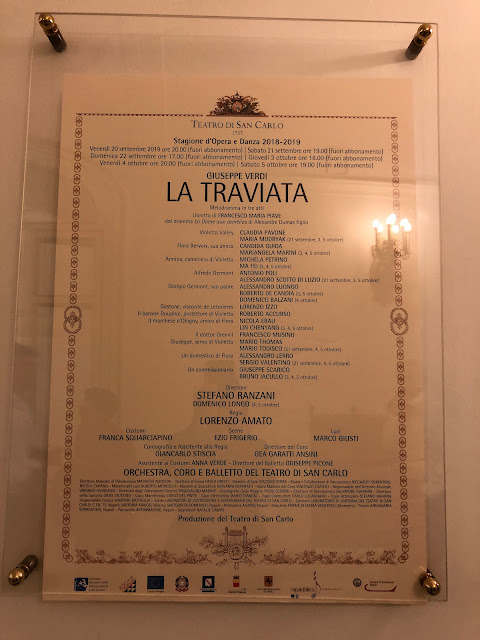サン・カルロ劇場でのこの日のプログラムは、ジュゼッペ・ヴェルディの『椿姫』。
日本では、椿姫の名前で知られているが、現代はプログラムにもあるように、『LA TRAVIATA』。traviataというイタリア語には、”道を踏み外した”という意味があり、娼婦を表す言葉になっている。
原作は、1848年に出版されたフランスのアレクサンドル・デュマ・フェスの小説で、こちらは”椿の花の貴婦人”という題名だった。
この小説は、作者本人の実体験が元になっていて、本人によって戯曲も書かれて、1850年から上演されて舞台は大成功した。
ヴェルディは、その舞台を1852年に見て感激し、1853年の初め頃までには作曲を完成させて、早くも1853年3月には、ヴェネツィアのフェニーチェ劇場で初演された。
しかし、あまりにも急いで初演を迎えようとしたためか、準備不足は明らかで、この初演は大失敗となった。その後、十分に準備を重ねて、翌年の公演では大成功を収め、ヴェルディの代表的なオペラの一つに数えられるようになった。
The program for the day at Teatro San Carlo was Giuseppe Verdi's La Traviata.
In Japan, it is known by the name "Camellia princes", but in modern times it is called ``LA TRAVIATA'', as the program says. The Italian word traviata means ``astray'' and is a word used to describe a prostitute.
The original work is a French novel written by Alexandre Dumas, published in 1848, and was titled ``The Lady of the Camellias''.
This novel was based on the author's own personal experiences, and he also wrote a play, which was performed on stage from 1850 and was a great success.
Verdi saw the play performed in 1852 and was impressed, and by the beginning of 1853 he had completed the composition, and as early as March 1853, it was premiered at the Teatro La Fenice in Venice.
However, perhaps because they tried to hold the premiere in such a hurry, it was obvious that they lacked preparation, and the premiere was a huge failure. After much preparation, the performance the following year was a great success, and it became one of Verdi's most representative operas.
このサン・カルロ公演の『椿姫』は、過去の公演を映像で見たことがあった。
その時は、まさか将来、この同じ劇場でその『椿姫』を見ることになるとは、想像もしていなかった。
このオペラには、ソプラノのヴィオレッタ、ヴィオレッタに恋するテノールのアルフレード、そしてバリトンのアルフレードの父親という3人が主要な配役になっている。
出演者の名前をよく見ると、アルフレードの父親役の人物は、過去に映像で見た公演では、息子のアルフレード役を演じていた人物だった。
それが、このオペラ・ハウスの伝統なのかどうか、たまたまその人物がテノールからバリトンに転向しただけなのかはわからないが、伝統が引き継がれているような気がした。
公演の内容は素晴らしく、幸い、舞台に近い良い席で見ることができたので、オペラの世界にどっぷりと使って作品を楽しむことができた。
I had seen a video of a past performance of ``La Traviata'' performed in San Carlo.
At that time, I never imagined that I would see La Traviata in the same theater in the future.
The opera has three main casts: the soprano Violetta, the tenor Alfredo who is in love with Violetta, and the baritone Alfredo's father.
If you look closely at the names of the performers, the person playing Alfredo's father was the person who played the role of Alfredo's son in a performance I saw in the past.
I don't know if it's the tradition of the opera house, or if the person just happened to switch from tenor to baritone, but it felt like the tradition was being carried on.
The content of the performance was excellent, and fortunately I was able to see it in a good seat close to the stage, so I was able to fully enjoy the world of opera.
ヴェルディと、このサン・カルロ劇場の縁は、それほど深いとは言えない。
ヴェルディのオペラの中では、アルティーラ(1845年)とルイザ・ミラー(1849年)という2つの作品しか、この劇場では初演されていない。
ヴェルディが活躍した19世紀の後半は、すでにこのサン・カルロ劇場は18世紀に誇っていたかつての勢いは失われていた。
それよりも、このオペラの題名の一部にもなっている”椿”の方が、この劇場のあるナポリに縁がある。
椿の学名は、カメリア・ジャポニカ。日本原産の植物で、オランダ経由でヨーロッパに持ち込まれたが、1782年にナポリ近郊のガゼルタ宮殿に植えられた。
その後、この花はヨーロッパ中に広まり、パリでも大流行した。
小説の椿姫では、ヴィオレッタは、生理の時だけ赤い椿を身につけ、それ以外は白い椿を見つけていた。
そうした意味では、椿が最初にヨーロッパに植えられた地で、その椿をテーマにしたオペラを聴くことはできたのは、とても良い思い出になった。
The connection between Verdi and the Teatro San Carlo cannot be said to be very deep.
Only two of Verdi's operas, Altira (1845) and Louisa Miller (1849), were premiered at the theatre.
In the second half of the 19th century, when Verdi was active, the Teatro San Carlo had already lost the momentum it once boasted in the 18th century.
More than that, "camellia," which is part of the title of this opera, has more ties to Naples, where this theater is located.
The scientific name of camellia is Camellia japonica. A plant native to Japan, it was brought to Europe via Holland, but was planted in 1782 at the Palace of Gazelleta near Naples.
The flower then spread throughout Europe, and even became popular in Paris.
In the novel La Traviata, Violetta wears a red camellia only when she is on her period, and wears white camellias at other times.
In that sense, being able to listen to an opera on the theme of camellias in the place where camellias were first planted in Europe became a very good memory.





コメント
コメントを投稿